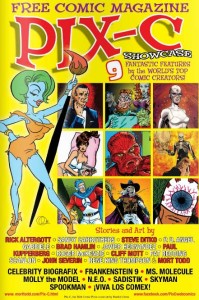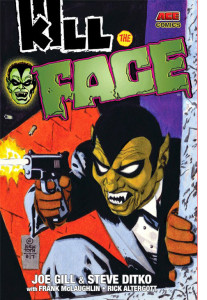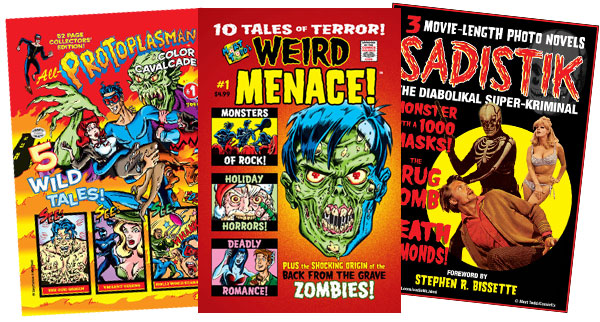Mort Todd Talks About Making Comics

Mort Todd has made his career in comics, animation, and entertainment. As a youth, he began drawing and writing comics and working as editor of his camp newspaper. Then in high school he drew ads and record covers for local clubs and bands. As a teen, he moved to New York City and began creating classic garage punk album covers from Crypt Records. At 23 he became the Editor-in-Chief of Cracked magazine working with legendary artists like John Severin, Bill Ward and Steve Ditko. Todd went on to make headlines by getting renowned Mad Magazine artist, Don Martin, after a 32-year career to jump ship from Mad to join Cracked.
Currently, Mort’s media company Comicfix develops licensed properties for publishing, film, TV and animation. For the last year, Comicfix has been putting out an eclectic variety of comics, mixing the classical aspects of the comics people grew up with, along with a modern sensibility. The incredible talent involved ranges from legends of the comics industry, to some very familiar names as well as promising new talent. We personally got the opportunity to meet Mort when he headed up Marvel Comic’s music comic division (pitching him a possible adaptation of Meatloaf’s Bat Out of Hell II: Back into Hell album), and recently got to chance to ask Mort about Comicfix and some of his other on-going projects, including resurrecting Charlton Comics with the help of his friends, including Roger McKenzie and Paul Kupperberg.
**********
Robert J Sodaro: You have a long history in comics ranging from editor-in-chief of Cracked magazine, and Marvel Music to having worked on Superman, Spider-Man, Barbie, and Looney Tunes. Now you are the owner of Comicfix, a media company. How did you go from one to the other, or is your work with Comicfix merely an outgrowth of your earlier comicbook work?
Mort Todd: Ever since I was a youngster, I’ve been interested in every kind of media: TV, film, animation, music and print, and I’ve been fortunate to dabble in all of it. Comicfix is indeed an outgrowth of what I’ve done and an outlet to create the above mentioned media.
RJS: You recently launched a crowd-sourcing fund-raiser on patron.com entitled Mort Todd is creating comic books and graphic novels, where you are seeking funding for a couple of distinct lines of comics. Tell us what that is all about.
 MT: I started Comicfix in 2000 to develop comic properties for TV, film, and licensing. Over the years I’ve collaborated with a variety of creators with the same goal. While initially Comicfix featured all my own properties, I’ve launched some distinctive other imprints under the Comicfix umbrella. Writer Brad Hamlin had created a full line of characters, the Secret Society, for the web and print that I’ve visualized under the Mystery Island brand. I did some work in the ‘80s for publisher Ron Frantz and his B&W ACE Comics line and we’ve partnered up to re-release some of those titles in color and create new ones. And a group of like-minded nuts have come together to reanimate the spirit of Charlton Comics with our Charlton Neo line. There’s a lot of cost in creating these comics and not a lot of reward until you make some progress. The Patron campaign is to attract fans of what we’re doing and to help operating costs until we can reach a wider audience.
MT: I started Comicfix in 2000 to develop comic properties for TV, film, and licensing. Over the years I’ve collaborated with a variety of creators with the same goal. While initially Comicfix featured all my own properties, I’ve launched some distinctive other imprints under the Comicfix umbrella. Writer Brad Hamlin had created a full line of characters, the Secret Society, for the web and print that I’ve visualized under the Mystery Island brand. I did some work in the ‘80s for publisher Ron Frantz and his B&W ACE Comics line and we’ve partnered up to re-release some of those titles in color and create new ones. And a group of like-minded nuts have come together to reanimate the spirit of Charlton Comics with our Charlton Neo line. There’s a lot of cost in creating these comics and not a lot of reward until you make some progress. The Patron campaign is to attract fans of what we’re doing and to help operating costs until we can reach a wider audience.
RJS: How can people contribute to that, and how is that campaign going?
 MT: Like a lot of grass-root campaigns it’s had a slow start, but is growing as people hear about it. Those interested can go to the link you mentioned above and donate whatever they want, from $1.00 up, to be a patron of the comic arts. For a dollar they get access to our Pix-C web comic site where we have over a dozen strips with new episodes posted weekly by a bunch of talented creators doing comics ranging from heroes to horror and humor. Donate more and you get print comics, posters, t-shirts and even original art.
MT: Like a lot of grass-root campaigns it’s had a slow start, but is growing as people hear about it. Those interested can go to the link you mentioned above and donate whatever they want, from $1.00 up, to be a patron of the comic arts. For a dollar they get access to our Pix-C web comic site where we have over a dozen strips with new episodes posted weekly by a bunch of talented creators doing comics ranging from heroes to horror and humor. Donate more and you get print comics, posters, t-shirts and even original art.
RJS: What do you think is the fascination with a company like Charlton Comics? Sure, a bunch of creators came out of the company, when it was operating years ago, but why do people (pros and fans alike) seem to care so much about this company and its characters?
MT: Charlton was always the underdog when compared to bigger publishers like Marvel and DC. As a smaller company they were more willing to experiment with their titles and try out concepts the larger companies wouldn’t do. And the creators had the freedom to do more wild stuff than they would be able to with the big guys.
RJS: With the help of guys like Paul Kupperberg and Roger McKenzie the Charlton line really seems to be taking off, you have three titles either out or in the works and have more on the way. Do you think that you’ll actually be able to resurrect the company as a going concern, or do you just plan on publishing “Charlton-themed” comics?
MT: We’ll be putting out at least six Charlton Neo titles a year, and hope to increase the output if response warrants it. Like the original Charlton, we’re such a small concern that creators are free to do their own thing, and all the features are creator-owned. The Charlton Arrow is an anthology book featuring a mix of genres. Charlton Wild Frontier is a Western comic featuring some Charlton characters like Cheyenne Kid and Kid Montana along with new ones. Paul Kupperberg’s Secret Romances is an oddball romance title with all stories written by Paul and a bunch of different artists. In the works are Charltoons, a funny animal book, and Roger McKenzie’s Total Frenzy Comics and Unusual Suspense. The last two titles are print versions of some Pix-C strips, including revamps of some Charlton characters. Also with ACE Comics, we’re reprinting Charlton’s Hot Rod comics from the ‘60s. Ron Frantz acquired the rights and we are printing from Charlton’s silver prints, used to publish the original comics.
RJS: Who currently owns the licenses to those characters, and how do you get to use the Charlton name and characters if you guys don’t own the license?
MT: Charlton went out of business in the late ‘80s, so a lot of the material is in the public domain. They did sell off some of their assets to others, most notably their action heroes like Blue Beetle and Captain Atom to DC Comics, so we stay away from those and utilize their less well-known, but still beloved, characters.
RJS: In addition to Charlton, you are also publishing ACE Comics and comics under the Comicfix logo, can you tell us what those comicbook lines are about, and how they differ from the Charlton titles.
 MT: ACE features the properties owned by Ron Frantz, including Skyman and the Face, which were drawn by Steve Ditko in the ‘80s. We’re also reprinting some of those character’s Golden Age stories to celebrate their 75th anniversary this year. Ron also has many great titles that were scheduled but never released back then that we’ll be putting out, like an incredible graphic novel by C.C. Beck. A few of the ACE titles are reprints, like the Classic Hot Rod and Racing Car Comics, but we have some new material planned as well. Comicfix does a little of everything, from horror to photo comics and tend to be the properties I’ve personally created or own.
MT: ACE features the properties owned by Ron Frantz, including Skyman and the Face, which were drawn by Steve Ditko in the ‘80s. We’re also reprinting some of those character’s Golden Age stories to celebrate their 75th anniversary this year. Ron also has many great titles that were scheduled but never released back then that we’ll be putting out, like an incredible graphic novel by C.C. Beck. A few of the ACE titles are reprints, like the Classic Hot Rod and Racing Car Comics, but we have some new material planned as well. Comicfix does a little of everything, from horror to photo comics and tend to be the properties I’ve personally created or own.
RJS: Do you think your ability to attract both seasoned pros and newbie creators to these titles has to do with the overly-corporate nature of the current state of comics?
MT: Sure. Comics are mostly superhero titles now, with stifling continuity. Our books offer creators the opportunity to expand the comic medium with different concepts and characters and try out things you couldn’t do at the “majors.”
RJS: It seems that the Big Two are allowing seasoned pros with extraordinary talent to slip out of their grasp, do you think that has to do with a perception that “older” creators are simply passé, and perceived (either by the corporations or by the fans) as no longer being relevant?
MT: When I got into the industry in the ‘80s it appeared that if you had been doing comics for the last 20 years, Marvel and DC weren’t interested in using you and they were in search of the “hot” new talent. People like Steve Ditko and Gene Colan couldn’t find regular assignments and I was glad to work with them. And it hasn’t changed since then; the “hot” artists of the ‘80s & ‘90s now find it hard to get work. Again, I’m more than happy to work with anybody that has talent.
 RJS: Do you see the revival of Charlton, Ace Comics, and Comicfix to be viable concerns and that you’ll be able to increase your audience share as you move forward?
RJS: Do you see the revival of Charlton, Ace Comics, and Comicfix to be viable concerns and that you’ll be able to increase your audience share as you move forward?
MT: For sure! Comics are more popular than ever, but more limited than ever. Mainstream comics aren’t too attractive to a wide audience as they are all about superheroes and have a vast continuity with never-ending chapters that potential customers can’t just dip into. Our books have shorter stories, more variety, usually told in under 10 pages, so the casual reader can read a complete adventure without having to buy 50 issues of crossovers. There is a wider potential audience for these kinds of comics than the current hardcore comic fan market attracts.
RJS: Any plans of getting Diamond distribution?
MT: Indeed. That is one of the goals of the Patron campaign, to be able to fund print runs and sell via Diamond.
RJS: Given that distribution for Independent, small press, and “non-corporate” comics is so difficult (and that Diamond’s rules and regulations are so restrictive) do you foresee any chance of a new distributor stepping up to handle the comics that Diamond doesn’t or won’t distribute?
MT: Possibly. We’re also looking into alternate distribution to reach those who wouldn’t normally enter a comics shop. Of course it would help to have a property that is also exposed on other media platforms like TV, film, or animation and we’re working on that, too!
RJS: With Hollywood looking at comics as its new source material, do you think that Indy comics stand a chance against corporate comics in that marketplace?
MT: Yes. Good story-telling will always sell. And a surprising number of independent, non-superhero comics are making it to the theater and TV screens.
RJS: What (else) are you doing to get attention and distribution for your line(s) of comics? And what else do you think is a viable way to get your comics out into the marketplace.
MT: Licensing is the best way to get your product known outside of comic fandom. We’re close to signing a film deal for one of our titles Sadistik, The Diabolikal Super-Kriminal, which is a photo comic with a worldwide cult following. I’m confident that with a successful release it will open the floodgates with others looking at our properties and in turn attracting readers to our books.
RJS: How difficult is it for Indy/Small Press comics to get out into comic shops?
MT: It’s mostly an issue of capital. It takes a bit of money to get the ball rolling what with having to bankroll editorial, printing, and promotional costs for a while before you see any return. And it also helps to have some content that people will actually like and look forward to with continued release!
Charlton Arrow, Charlton Neo, Pix-C, all artwork displayed, as well as all material mentioned in this article is © & TM 2015 their respective copyright holders. All rights reserved.
Funnybook City is © 2015 Robert J. Sodaro, D.B.A. Freelance Ink. All rights reserved.
Robert J. Sodaro is a noted comicbook historian and journalist who began reading comics during the early ‘60s while sitting on the newsstand in his Uncle’s “Mom & Pop” grocery store. He has written about them for virtually every print comicbook publication published during the ‘80s & ‘90s. These days, much of his writing can be found on Examiner.com.



Leave a Reply